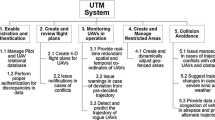Abstract
The System Wide Information Management (SWIM) approach has been conceived to overcome the capacity and flexibility limitations of the current ATM systems. On the other hand the commercial applications of Unmanned Aerial Vehicles (UAVs) require the integration of these vehicles in the ATM. From this perspective, the unavoidable modernization of the ATM is seen as an opportunity to integrate the UAVs with the rest of the air traffic. This paper is devoted to study the feasibility and impact of the aggregation of UAVs on the future ATM supported by a SWIM inspired architecture. Departing from the existing technical documents that describe the fundamentals of SWIM we have explored the compatibility with a potential UAVs integration and also explored how the UAVs could help to improve the future ATM system. We will use the weather application as an example in both cases.
Similar content being viewed by others
References
Boeing Technology: Phantom works. Advanced Air Technology Management. http://www.boeing.com/phantom/ast/61605_08swim.pdf. Accessed 24 October 2007
SWIM Program Overview: http://www.swim.gov (redirects to www.faa.gov). Accessed 9 May 2008
System-Wide Information Management (SWIM) Architecture and Requirements. CNS-ATM Task 17 Final Report, ITT Industries, Advanced Engineering and Sciences Division, 26 March 2004
Jin, J., Gilbert, T., Henriksen, S., Hung, J.: ATO-P (ASD 100)/ITT SWIM Architecture Development. CNS-ATM, 29 April 2004
Koeners, G.J.M., De Vries, M.F.L., Goossens, A.A.H.E., Tadema, J., Theunissen, E.: Exploring network enabled airspace integration functions for a UAV mission management station. 25th Digital Avionics Systems Conference, 2006 IEEE/AIAA, Oct. 2006, pp. 1–11
Carbone, C., Ciniglio, U., Corraro, F., Luongo, S.: A novel 3D geometric algorithm for aircraft autonomous collision avoidance. In: 45th IEEE Conference on Decision and Control (CDC’06), pp. 1580–1585. San Diego, California, December 2006
UAV safety issues for civil operations (USICO), FP5 Programme Reference: G4RD-CT-2002-00635
Le Tallec, C., Joulia, A.: IFATS an innovative future air transport system concept. In: 4th Eurocontrol Innovative Research Workshop, December 2005
UAV Roadmap 2005–2030 – Office of the Secretary of Defense, August 2005
Everaerts, J., Lewyckyj, N., Fransaer, D.: Pegasus: design of a stratospheric long endurance UAV system for remote sensing. In: Proceedings of the XXth ISPRS Congress, July 2004
Weather Information Interface: http://aviationweather.gov/. Accessed 9 April 2007
metaf2xml: convert METAR and TAF messages to XML. Project web site: http://metaf2xml.sourceforge.net/. Accessed 25 May 2006
FlightGear Flight Simulator Project Homepage: http://www.flightgear.org/. Accessed 5 May 2008
Meserole, C.: Global communications, navigation, & surveillance systems program – progress and plans. In: 5th Integrated CNS Technologies Conference & Workshop, May 2005
Romeo, G., Frulla, G.: HELIPLAT: high altitude very-long endurance solar powered UAV for telecommunication and earth observation applications. Aeronaut. J. 108(1084), 277–293 (2004)
Merino, L., Caballero, F., Martínez-de Dios, J.R., Ollero, A.: Cooperative fire detection using unmanned aerial vehicles. In: Proceedings of the 2005 IEEE, IEEE International Conference on Robotics and Automation, Barcelona (Spain), April 2005
Ollero, A., Maza, I.: Multiple Heterogeneous Unmanned Aerial Vehicles. Springer Tracts on Advanced Robotics. Springer, Berlin (2007)
Aeronautical Information Management Strategy, V4.0. EUROCONTROL, Brussels, Belgium March 2006
Merino, L., Caballero, F., Martínez-de Dios, J.R., Ferruz, J., Ollero, A.: A cooperative perception system for multiple UAVs: application to automatic detection of forest fires. J. Field Robot 23(3), 165–184 (2006)
Beard, R.W., Kingston, D., Quigley, M., Snyder, D., Christiansen, R., Johnson, W., McLain, T., Goodrich, M.: Autonomous vehicle technologies for small fixed-wing UAVs. J. Aerosp. Comput. Inform. Commun. 2(1), 92–108 (2005)
Alcázar, J., Cuesta, F., Ollero, A., Nogales, C., López-Pichaco, F.: Teleoperación de helicópteros para monitorización aérea en COMETS (in Spanish). XXIV Jornadas de Automática (JA 2003), León (Spain), 10–12 Septiembre 2003
Sørensen, C.F., Wu, M., Sivaharan, T., et al.: A context-aware middleware for applications in mobile AdHoc Environments. In: Proceedings of the 2nd Workshop on Middleware for Pervasive and Ad-hoc Computing Table of Contents. Toronto (2004)
Soetens, H., Koninckx, P.: The real-time motion control core of the Orocos project Bruyninckx, Robotics and Automation. In: Proceedings. ICRA ‘03. (2003)
Lam, T.M., Mulder, M., van Paassen, M.M.: Collision avoidance in UAV tele-operation with time delay, conference on systems, man and cybernetics. ISIC. IEEE International. Montreal, October 2007
Loh, R., Wullschleger, V., Elrod, B., Lage, M., Haas, F.: The U.S. wide-area augmentation system (WAAS). Journal Navigation 42(3), 435–465 (1995)
Author information
Authors and Affiliations
Corresponding author
Rights and permissions
About this article
Cite this article
Peña, N., Scarlatti, D. & Ollero, A. UAVs Integration in the SWIM Based Architecture for ATM. J Intell Robot Syst 54, 39–59 (2009). https://doi.org/10.1007/s10846-008-9254-1
Received:
Accepted:
Published:
Issue Date:
DOI: https://doi.org/10.1007/s10846-008-9254-1




